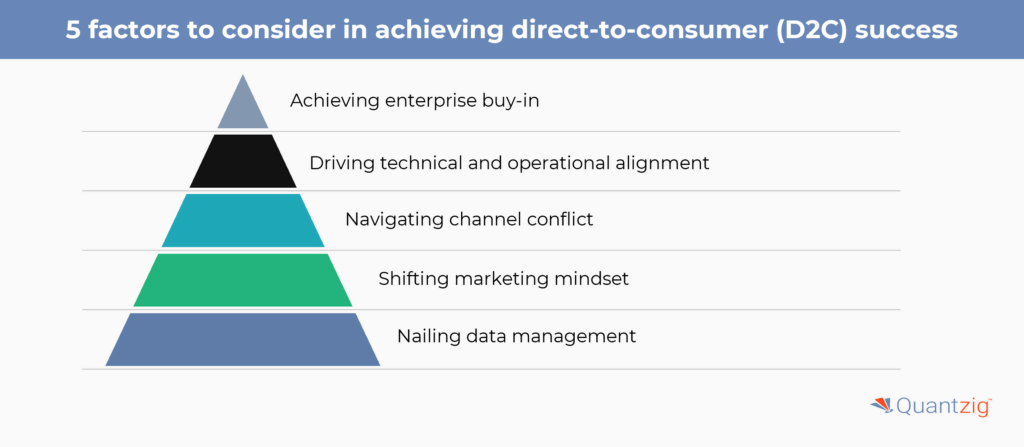Written by: Medha
Table of Contents
Introduction to Direct-to-Consumer Strategies
In today’s fast-paced consumer packaged goods (CPG) industry, where digital transformation is reshaping traditional business models, staying ahead of the competition requires a data-driven approach to product innovation and lifecycle management. With lower barriers to entry, digital-native startups and smaller competitors pose a significant threat to established players. Additionally, mainstream competitors are constantly seeking to disrupt the market with unique ideas. In such a dynamic landscape, CPG firms must embrace innovation D2c analytics solutions to identify emerging trends and opportunities while mitigating risks.
Book a demo to experience the meaningful insights we derive from data through our analytical tools and platform capabilities. Schedule a demo today!
Request a free demoChallenges in the CPG Direct to Consumer Landscape
The diversity of markets and the proliferation of digital signals present challenges for CPG firms seeking to isolate meaningful trends from the noise. Market fads often obscure genuine opportunities, making investments in market-driven innovation riskier. Identifying the right trends and opportunities early on is crucial for maximizing potential and gaining a competitive edge.
Read more: Navigating D2C Analytics Profitability with Data Analytic
The Direct to Consumer Marketing Strategy Solution: Innovation Analytics
Quantzig offers a comprehensive suite of Innovation Analytics toolkits designed to address the specific needs of CPG firms in Europe. Our solution enables decision-makers to navigate the entire product lifecycle with confidence, leveraging data-driven insights at every stage.
Pre Launch Intelligence
- Innovation Ideation & Market Trends: Identify emerging trends and whitespace opportunities through advanced data analytics.
- Concept Validation & Product Market Readiness: Validate product concepts and assess market readiness to minimize launch risks.
- PLM & Fast-Tracking Time to Market: Streamline product lifecycle management processes to accelerate time to market.
- Marketing Testing & Launch Planning: Optimize marketing strategies and launch plans based on actionable insights.
Post Launch Measurement & Management in Direct to Consumer Marketing Strategy
- Marketing & Campaign Strategy: Fine-tune marketing campaigns and strategies based on real-time performance data.
- Sales Enablement & Execution: Empower sales teams with data-driven insights to drive revenue growth.
- Performance Measurement & Management: Track key performance indicators and evaluate campaign effectiveness.
- Market Adoption & Consumer Read: Monitor market adoption rates and gather feedback from consumers to inform future decisions.
- Market & Competitive Intelligence: Stay ahead of competitors by leveraging insights into market dynamics and competitive landscape.
Experience the advantages firsthand by testing a customized complimentary pilot designed to address your specific requirements. Pilot studies are non-committal in nature.
Request a free pilotClient Success Story: Multinational Chocolate Manufacturer
Quantzig partnered with a multinational chocolate manufacturer headquartered in Europe to address their product innovation challenges. By leveraging our Innovation Analytics solution, we helped them identify potential future trends and whitespace opportunities within the CPG landscape. Our ML-based NLP solution categorized conversations across various platforms, enabling the client to pinpoint key innovation areas and validate them against real-world data.
The impact was significant. Our solution enabled systematic retargeting of key customer cohorts, leading to a 20% increase in repeat customer rate during the test period. Additionally, we provided valuable insights for campaign execution, resulting in more targeted messaging and improved campaign performance.
Get started with your complimentary trial today and delve into our platform without any obligations. Explore our wide range of customized, consumption driven analytical solutions services built across the analytical maturity levels.
Start your free trial5 factors to consider in achieving direct-to-consumer (D2C) success
1. Achieving enterprise buy-in
Unfortunately, D2C isn’t as simple as putting up a new website and calling it a day. But you knew that. It takes massive organizational alignment and perhaps even a tectonic shift in company priorities in order to do direct e-commerce well. There will be internal friction, perhaps even resistance, before you get there. It’s going to require new investments, new people, new skillsets and possibly even some re-organization. So it’s vital for executives to be bought in across the company, no matter what part of the business they own.
The point is, this is not something that should be done half-heartedly. There are myriad examples of retailers from the past decade and a half that never quite figured out ecommerce. Either they were too late to the party, didn’t prioritize e-commerce, weren’t organized properly, or—well, there are lots of reasons. But luckily for you there are plenty of good examples to follow, models to emulate and existing ideas to innovate from. How you go about this will be unique to your company’s existing culture, and Quantzig can help you through!
2. Driving technical and operational alignment
Consider this the tactical side of the coin to #1’s strategic. If factor #1 is ensuring the whole company understands what you’re going to do (and why), #2 is everyone fully understanding how you plan to do it. Ecommerce solutions are mature and there are no shortage of providers willing to help you get up and running in a reasonable timeframe. But there are lots of front-end and back-end IT decisions to be made here. Which website? What about order management? Do we need a PIM? Payment processing. Inventory management, warehousing and shipping. How will we handle the demand for increased customer service?
It’s also important to consider where e-commerce will sit within your organizational structure. Who “owns” ecommerce? You’ll need to think through operational logistics. Whereas previously you may have only offered your product by the pallet, your customers will likely want to buy a more manageable quantity. How you will make that happen is one of many key considerations.
3. Navigating channel conflict
Your retailers are important and you want to keep them happy. But this is a common barrier to going direct. The answer to how you will handle this very much depends on the individual relationships you have with your retail partners, but one way or another it should be handled proactively.
One common solution is to get creative. What could you offer as a result of now being vertically integrated that retail partners simply couldn’t? Perhaps it’s the opportunity for personalization. Other options to help avoid conflict include the ability to offer unique pricing, loyalty rewards, subscription services, different size and packaging options, or retail-specific product variations.
4. Shifting marketing mindset
D2C demands that you think a bit differently about marketing. You’ll be able to leverage the data you now have access to in new and creative ways to establish a conversation with your customers and prospective customers.
Personalization will play a large role here, as well. Nearly one-third of marketers said that their top priority for future marketing efforts was the ability to personalize messaging and offers for their customers.
5. Nailing data management
Did you know that nearly three-quarters (74%) of consumers get frustrated when website content isn’t tailored specifically to them? Consumers want to establish a relationship with the brands they love, but they also want to know that the feeling is mutual. In the D2C world, not only will you need rock-solid imagery, digital media content, and descriptions about your products, but you’ll also need to combine all of it with data about who your customers are and how they are interacting with your brands.
But executing this requires some very deliberate decisions about how you’ll manage data about your products and customers. Many manufacturers are beginning to handle this dilemma through a multidomain approach to data management. No longer do product information and customer data need to live in separate, hermetically sealed siloes.
Read more: Advantages of Behavioral Segmentation in the Fast Food Industry
Conclusion
Innovation Analytics has become indispensable for CPG firms looking to thrive in the dynamic D2C landscape. By leveraging data-driven insights, companies can identify emerging trends, mitigate risks, and drive faster time-to-market for new products. Quantzig’s comprehensive suite of toolkits offers tailored solutions to address the unique challenges faced by CPG firms, empowering them to stay ahead of the competition and delight consumers with innovative products and experiences.






